Toshiba Satellite A660D-ST2G01: AMD's Quad-Core Phenom II P920 Joins the Mobile Party
by Jarred Walton on August 31, 2010 12:45 AM ESTToshiba A660D-ST2G01 General Performance
As one of the first up-to-date AMD notebooks to hit our labs in a long time, the Toshiba A660D certainly piqued our interest. Where will the quad-core P920 fall in regards to the competition? How much will battery life improve? How does gaming fare? You've got questions, and we've got the answers. Here's a recap of the pertinent details of our test system.
| Toshiba A660D-ST2G01 Test System | |
| Processor |
AMD Phenom II P920 (4x1.6GHz, 45nm, 4x512KB L2, 25W) |
| Chipset | AMD RS880M Northbridge, AMD SB850 Southbridge |
| Memory | 2x2GB DDR3-1066 (Max 2x4GB) |
| Graphics |
ATI Mobility Radeon HD 4250 (40 Stream Processors, 500MHz Core, Integrated) ATI Mobility Radeon HD 5650 (400 Stream Processors, 450MHz Core, 1600MHz GDDR3) |
| Display |
16" LED Glossy 16:9 768p (1366x768) Samsung 160AT06-U01 |
| Hard Drive(s) | Toshiba 500GB 7200 RPM Hard Disk |
| Optical Drive | DVD+/-RW Combo Drive with LabelFlash |
| Battery | 6-Cell, 10.8V, 48Wh battery |
| Operating System | Windows 7 Home Premium 64-bit |
| Pricing |
Starting at $949 Online A665D-S6059: $800 Online |
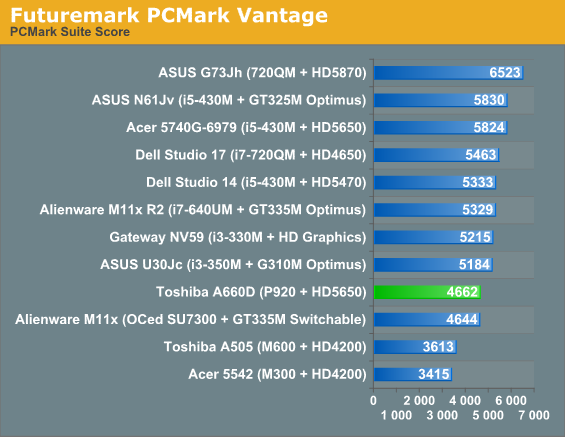
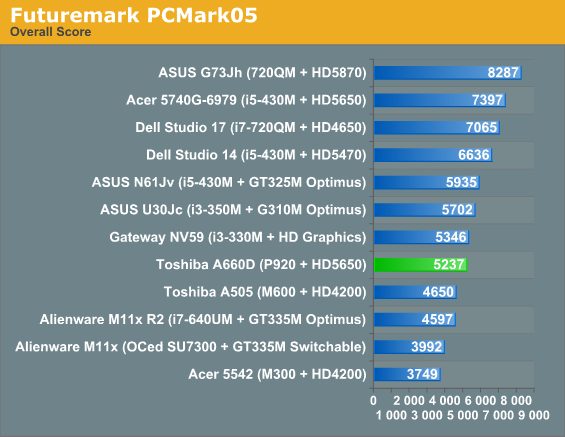


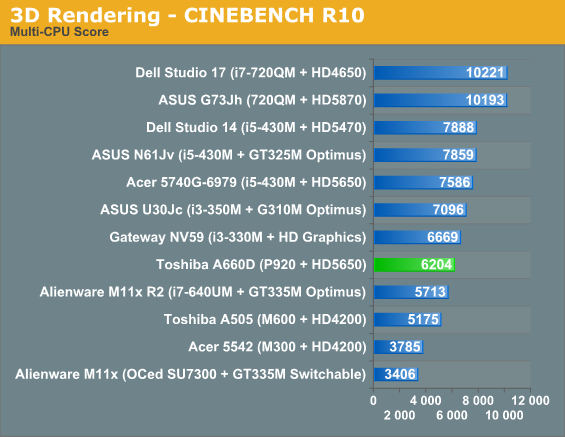
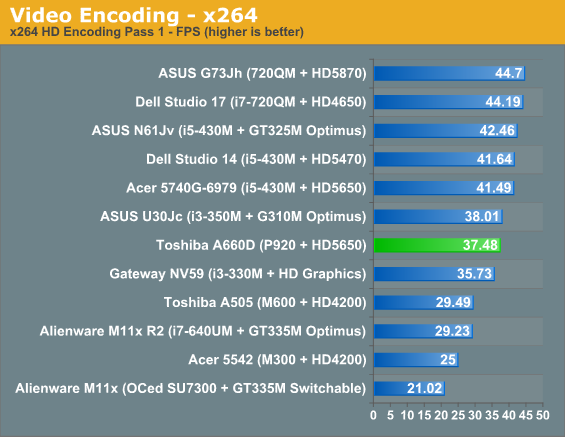
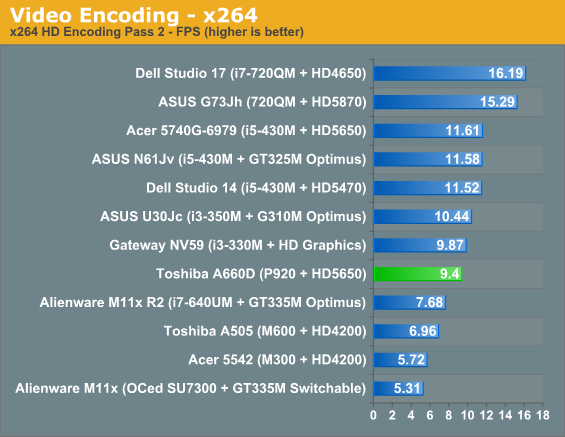
Starting off with PCMark Vantage and PCMark05, we get our first glimpse of the potential of the P920. Despite the lower clock speed, the P920 outpaces the Turion II M600 by 20% and the Athlon II M300 by 27% in Vantage. The gap is smaller in PCMark05, but that's obviously an old (outdated even) benchmark so we won't worry about it too much. That's the good news; the bad news is that Intel's slowest Core i3 processors are still faster in general application performance. The i3-330M with Intel HD Graphics is 20% faster, and the i5-430M with HD 5650 is 34% faster. The slow clock speed of the P920 just doesn't keep up in these types of workloads.
Peacekeeper shows the worst-case scenario where Intel's Turbo Boost is in full effect and the higher clocks of dual-core parts take front stage. On the AMD side, the M300 is 17% faster than the P920 and the M600 is 38% faster. Switch to Intel and the slowest i3-330M comes in 42% faster (ouch!), while the i5-430M is 54% faster. Heavily threaded tests don't do the P920 any favors either, as the i3-330M with Hyper-Threading still leads by a small amount in Cinebench SMP and x264 2nd pass. The only win for the P920 comes in the first pass of x264 encoding, where it's about 5% faster than the i3-330M.
What about the AMD quad-core versus Intel quad-core comparison? The ASUS G73Jh does come with a faster 5870 GPU, but even when we take that out of the picture the i7-720QM is clearly much faster than the P920. The gap is 50% in PCMark Vantage, and it goes up from there. The lead is 64% in Peacekeeper and 114% in the single-threaded Cinebench result, where Turbo Boost is in full effect. The lead in multi-core Cinebench is 64%, 2nd pass x264 is 63%, and the closest result is in the 1st pass x264 where the lead drops to just 19% (as memory and storage performance become bigger factors).
The P920 is certainly fast enough for most users, but the fact that a quad-core processor can't establish a lead over dual-core Intel parts even in multi-threaded tests is telling. Low power draws are good for battery life, but higher clock speeds are necessary to close the performance gap. We'd really like to see AMD put their Turbo Core technology from the desktop Phenom II X6 processors into their mobile parts, as the low 1.6GHz clock is definitely hurting performance in many tasks. In fact, there are a few instances where the overclocked SU7300 CULV processor (in the Alienware M11x) beats the P920. AMD does have some faster quad-core parts available, of course. N930 runs at 2.0GHz, which means it should be around 25% faster in CPU limited tasks, and the X920 BE runs at 2.30GHz, but those comes with 35W and 45 TDP, respectively. At lower loads those processors should use roughly the same power as the P920, but load power draw will be substantially higher.
The bottom line is that AMD's CPU cores could still use help, as clock for clock they're similar to the old Core 2 chips. Core 2 was available at speeds up to 3.07GHz dual-core and 2.53GHz quad-core, and even the fastest of those parts are surpassed by the midrange Core i3/i5/i7 parts. AMD is able to compete with Intel's old generation mobile hardware now, but that still means they're around 18 months behind. The result is that they need to sell at lower prices to stay relevant, and that's what they're doing.
Toshiba A660D-ST2G01 3DMark Performance
For those that like to compare 3DMarks, here are the results from the A660D (using the HD 5650 in all cases). Consider this a preview of the gaming performance on the next page.
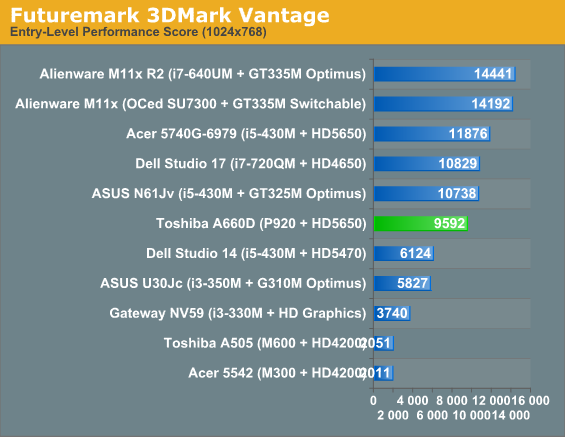
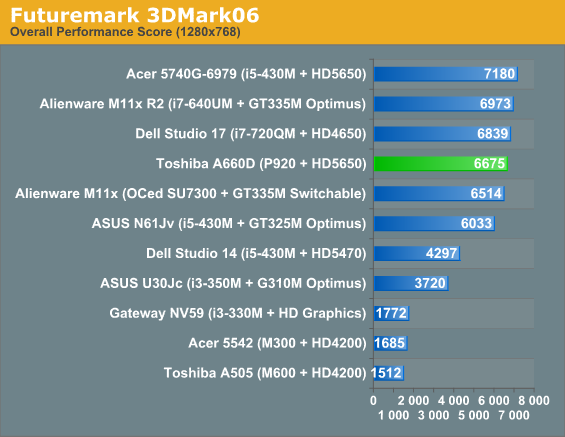
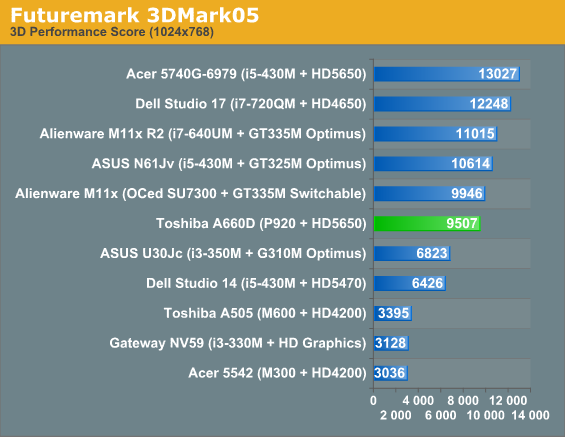
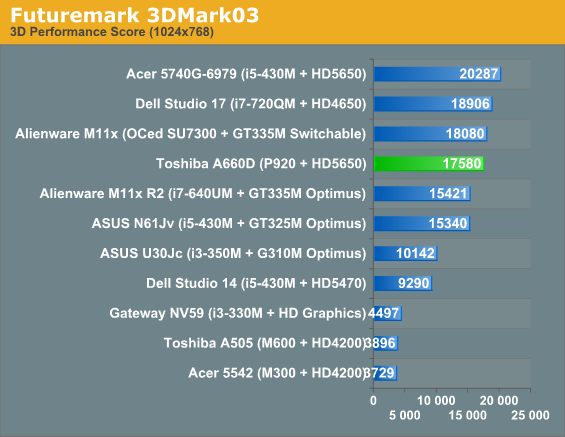
The only other HD 5650 system we've tested to date is the Acer 5740G (which is, sadly, discontinued—though you can get the 7740G if you don't mind the 17" chassis). As mentioned already, that 5650 was clocked at 550MHz compared to 450MHz in the A660D, plus it used an i5-430M CPU. The result is a performance lead of anywhere from 6% (3DMark06) to 36% (3DMark05) over the A660D, but what we don't know for sure is if the limiting factor is the CPU or the lower GPU clock. Most likely it's some of each, so let's look at actual gaming performance and see where the chips fall.










33 Comments
View All Comments
Dustin Sklavos - Tuesday, August 31, 2010 - link
Jarred, you are clearly a huge nerd. I'm obviously working with the right people.I'm pretty much drawing the same conclusions you are about this notebook. While I can't stand Toshiba's finishes, the real problem isn't Toshiba necessarily but that no one seems interested in producing a proper AMD notebook. The best you can do, I think, is custom-order one from HP (where at least you'll get an attractive build) or be prepared to make a lot of compromises.
It leads one to conclude that AMD's poor notebook market share can't solely be attributed to them...if the manufacturers don't make and market compelling machines using the available hardware, what can AMD really do?
Goty - Tuesday, August 31, 2010 - link
Sue Intel? Oh, wait, they did that already.Should be interesting to see the designs that come out with Bobcat.
fabarati - Tuesday, August 31, 2010 - link
Haha, Jared really is a big nerd.Too bad that Toshibia gimped the GPU in this one, and that the CPU still can't keep up. The AMD situtation is a bit of a catch 22: AMD has a (fairly rightly deserved) rumour of bad performance/batterylife, so people aren't willing to spend money on AMD laptops. The manufacturers see this, so they aren't willing to invest money in laptops people won't buy. That leaves us with cheap AMD laptops, or compromised expensive ones, that people won't buy.
fabarati - Tuesday, August 31, 2010 - link
"Computer, belay that order." Seriously, we need an edit button.I really miss the glory days of 16:10 as well. At least the manufacturers haven't gone further... yet. They might though. If they can get away with it, they'll probably go as far as 22:9, or at the very least 25:12 like in the Vaio P.
Personally, I'd pay extra for Intels performance, but that's me.
anactoraaron - Tuesday, August 31, 2010 - link
I think this is the thought process...Toshiba Assistant: "We made $XXXXXXX in profit for Intel notebooks last year and $XXX for AMD."
Toshiba Manager: "I guess we need to make better margins (lesser cheaper and charge more) on those AND or AMD or whatever you said that isn't making much money"
The result is us not getting a great well-rounded AMD notebook from any OEM (minus the custom build option mentioned). Shame really, and the 1366x768 on a 16 inch notebook is proof positive of that thought process. It isn't like if they build great AMD notebooks they wouldn't sell, it's just the ones they (the OEM's) make now aren't all that good - which is why they don't sell... and round and round we go...
Seriously, put in a better screen res and better 6 cell (or take a page from ASUS and put in an 8 cell) and sell it for $699 and watch it fly off the shelves.
SteelCity1981 - Tuesday, August 31, 2010 - link
The real question is why would you evenwant to consider a Phenom II X4 N920 in a laptop in which cost $950 dollars when you can get a Core i7 720QM laptop that cost roughly around the same price that would eat the Phenom II X4 N920 for lunch????? Nevermind the Core i5 series or even the Core i3 series for that matter that can rival the Phenom II X4 N920 in performance and has bettery battery life on avg for a lot less. The Phenom II X4 N920 would be much better suited in the $600 dollar price range where the Core i3's are than in the $900 dollar price range it's in now.Roland00 - Tuesday, August 31, 2010 - link
You are mixing your model numbers up.The P920 is a 1.6 ghz AMD Quad Core with a 25w TDP
The N930 is a 2.0 ghz AMD Quad Core with a 35w TDP
The N930 is 25% faster and is a much better cpu if you don't mind the extra tdp (which is not necessary the same as battery life). Pretty much the N930 is competitive with intel i line of chips but the P920 is not competitive.
SteelCity1981 - Tuesday, August 31, 2010 - link
Um not i'm not. the Toshiba Satellite A660D-ST2G01 cost $950 with the N920 cpu.Roland00 - Tuesday, August 31, 2010 - link
Here is the direct link of the model on toshiba websitehttp://laptops.toshiba.com/laptops/satellite/A660/...
Note the processor is a P920. Also read the first page of the review note Jared said the processor is the P920 at 1.6 Ghz. There is no such thing as a N920 processor from AMD, there is only a P920 and a N930 (which is 25% faster but has a 35w tdp instead of 25w)
The price is 949 which no one disagrees with. The speed sucks compared to the intel which no one disagrees with. The N930 processor speed is comparable to the Core I series of intel processors.
JarredWalton - Wednesday, September 1, 2010 - link
Given the A665D has an MSRP of $899 and sells at Newegg for $799, the real issue is the MSRP; I suspect the retail outlets will carry this notebook for a price closer to $850. It's still too much I think, but some will like the inclusion of ExpressCard/34 perhaps.The problem is that I figure there's only about $350 in the cost of a quad-core i7-720QM Intel chip (and that's being generous as OEMs probably get it for a lot less--wouldn't be surprised if they pay closer to half that much). But AMD's mobile parts aren't even remotely competitive with 720QM, so let's look at i5-520M. Intel pricing there is $225, and again OEM pricing has to be less than that.
Motherboards, chipsets, chassis, power, LCD, HDD, etc. are pretty much the same whether you get Intel or AMD. If you put together reasonable costs on all of those, a notebook like the A660 series (Intel or AMD models) costs something like $450-$550 just in materials without a processor. So the bottom line is you're looking at trying to build a laptop where the most money you can easily cut off by switching from Intel to AMD is maybe $100, and possibly not even that. AMD notebook bill of materials comes to perhaps $650 in this case, while the Intel notebook might come to $750 (depending on build order discounts).
If this notebook were priced at $699 as someone suggested above, it would be very close to losing money on each one produced. Though I suppose my math and estimates could be off, but R&D costs money too....